Apple iPad 2 GPU Performance Explored: PowerVR SGX543MP2 Benchmarked
by Anand Lal Shimpi on March 12, 2011 3:04 PM EST- Posted in
- Smartphones
- Apple
- iPad
- GLBenchmark
- iPad 2
- Mobile
- Tablets
GLBenchmark 2.0
GLBenchmark 2.0—as its name implies—tests OpenGL ES 2.0 performance on compatible devices. The suite includes two long benchmarking scenarios with a demanding combination of OpenGL ES 2.0 effects - texture based and direct lighting, bump, environment, and radiance mapping, soft shadows, vertex shader based skinning, level of detail support, multi-pass deferred rendering, noise textures, and ETC1 texture compression.
GLBenchmark 2.0 is the best example of an even remotely current 3D game running on this class of hardware—and even then this is a stretch. If you want an idea of how the PowerVR SGX 543MP2 stacks up to the competition however, GLBenchmark 2.0 is probably going to be our best bet (at least until we get Epic to finally release an Unreal Engine benchmark).
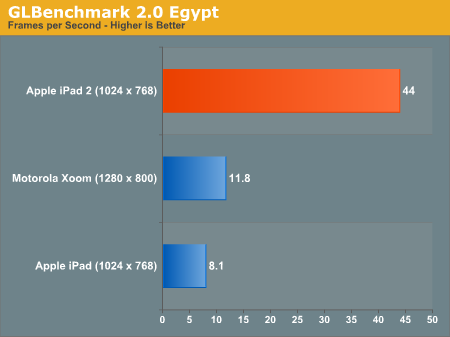
Without AA, the Egypt test runs at 5.4x the frame rate of the original iPad. It's even 3.7x the speed of the Tegra 2 in the Xoom running at 1280 x 800 (granted that's an iOS vs. Android comparison as well).
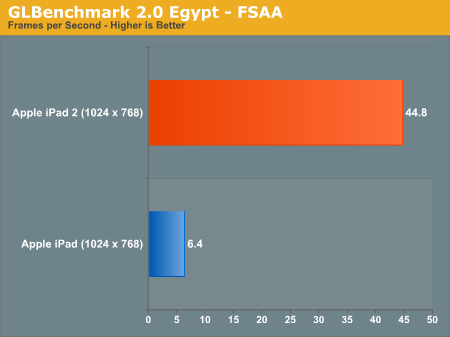
With AA enabled the iPad 2 advantage grows to 7x. In a game with the complexity of the Egypt test the original iPad wouldn't be remotely playable while the iPad 2 could run it smoothly.
The Pro test is a little more reasonable, showing a 3 - 4x increase in performance compared to the original iPad:
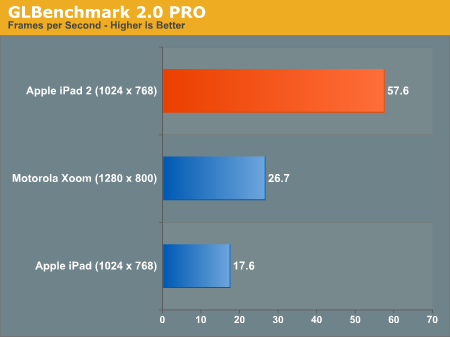
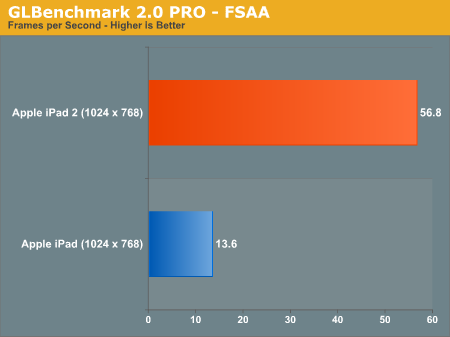
While we weren't able to reach the 9x figure claimed by Apple (I'm not sure that you'll ever see 9x running real game code), a range of 3 - 7x in GLBenchmark 2.0 is more reasonable. In practice I'd expect something less than 5x but that's nothing to complain about. We'll be doing power analysis over the weekend so expect more detail in our full review.
Putting the PowerVR SGX 543MP2 to Use: Infinity Blade
As we pointed out in our iPad 2 Preview, at least one developer already picked up on the amount of extra GPU horsepower in the new iPad 2. Epic put out an updated version of Infinity Blade with support for the iPad 2. Run it on an iPad and you'll get the same old Infinity Blade, but run it on an iPad 2 and you'll get more detail, higher resolution textures and anti-aliasing.
Remember that iPad and iPhone devices are more closed than your PC. There's no adjusting detail settings or resolution, so the target frame rate is usually what's fixed. Developers are simply able to deliver a better looking experience at roughly the same frame rate with upgraded hardware. In the case of Infinity Blade, load times are reduced thanks to the Cortex A9 CPU cores and there is some improvement in frame rate but the biggest impact comes from the improved visuals.
Below is the comparison beween Infinity Blade on the iPad and iPad 2 we ran in this morning's preview:
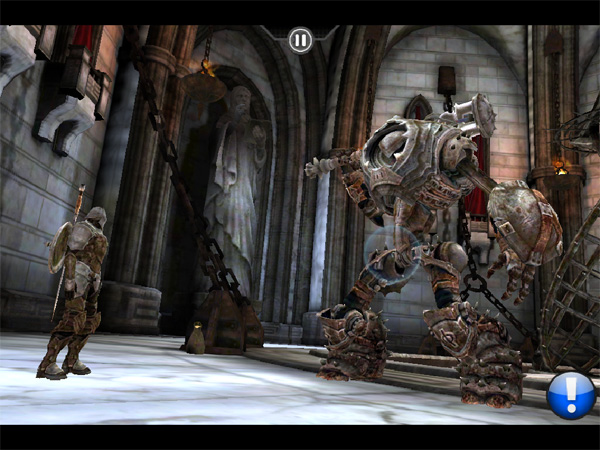
Mouse over to see Infinity Blade on the iPad 2
There's far more detail in the character models as well as the environment. Lighting looks improved and the AA is definitely appreciated.
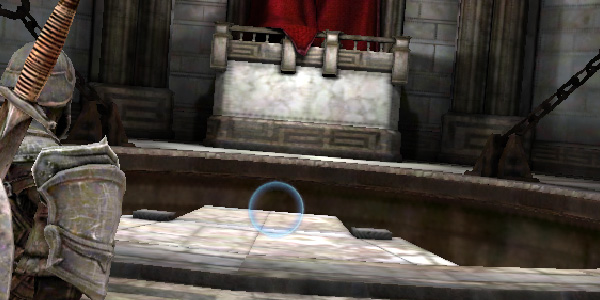
Mouse over to see Infinity Blade on the iPad 2
The gallery below has a bunch of side by side shots showing the improvements made to Infinity Blade for the iPad 2 vs. what you get when you run the game on a first generation iPad.
To Be Concluded...
We're still hard at work on our full iPad 2 review. We've got no less than four units running through battery life tests right now and there's still more to talk about in the review. We'll keep you posted, thanks for reading!


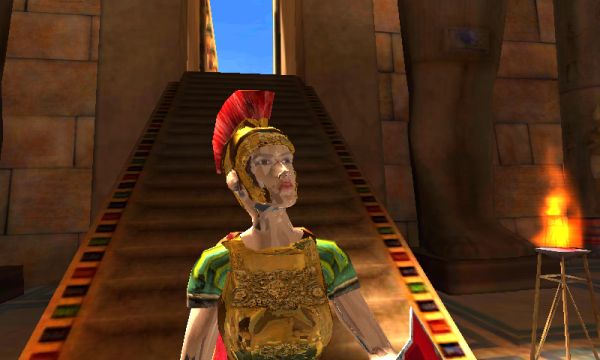














219 Comments
View All Comments
mech0r - Friday, March 18, 2011 - link
"I suspect that number is still wildly inflated and falling fast."Wtf are you Steve Jobs himself? Or did you just say that cuz stevie told you that?
why do you "suspect" and not go "research" before repeating mindlessly what your cult leader tells you
tipoo - Saturday, March 12, 2011 - link
Possibly 3G/non 3G, and first generation being tested again too.BrooksT - Saturday, March 12, 2011 - link
What do you want? The iPad is >80% market share in a market Apple created. iPad 2 is kind of a big release.Do you think Anand or elsewhere should ignore market share, history, and user interest when deciding amount of coverage? Does avoiding "favoritism" mean giving equal amounts of coverage to Intel and Via CPUs?
Anand Lal Shimpi - Saturday, March 12, 2011 - link
There are three different models that we're testing (AT&T, Verizon and WiFi) and we've got a second WiFi that we borrowed so we can speed up battery life testing. Apple doesn't actually sample us most of the time and all Apple review samples go back after ~30 days (and we never accept money for reviews so that's out of the discussion as well). Because we don't get sampled, we have to do a lot of parallel testing in order to still deliver timely reviews. Not to mention that given the baseband issues we've seen in the past with Apple and other recently released smartphones, we want to have as many datapoints as possible to make sure we discover any issues that may exist.The PowerVR SGX 543MP2 is a particularly interesting GPU. It's something we'll see variants of in other SoCs going forward. We would've shown the same excitement and rush to test for any other platform that it debuted on.
As far as the pictures go. We have different folks do the photos for each article. Some products are easier to photograph in a way that looks cooler. I'd argue that the Atrix and Nexus S shots are just as good as what we've published here.
Take care,
Anand
chrnochime - Saturday, March 12, 2011 - link
Anand,Do you know or could you tell us which other tablet that's coming up in 2011 would sport a variant of the SGX 543MP2(or 4)? Now that your test shows the GPU is actually substantially quicker than the Tegra2, I would want to wait for some other tablet that sports a larger resolution.
Thanks.
metafor - Monday, March 14, 2011 - link
To date, I don't believe any have been announced. IIRC, TI is the only other SoC manufacturer with the 543MP in their roadmap and that won't be until the OMAP5 series next year.But that doesn't necessarily mean no one will catch up to the iPad 2 in GPU performance. Many manufacturers (Samsung, ST) are using ARM's Mali core, which if scaled up could be competitive. nVidia has their next-generation Geforce ULP coming in Tegra 3 and Qualcomm has their Adreno 220 later this year, so there are plenty of players.
KoolAidMan1 - Saturday, March 12, 2011 - link
Get over yourself.The iPad sold 15 million units in a year and the iPad 2 will likely double that. No other tablet will come anywhere close to that. It is obvious why Anand is covering that device.
It is also funny that you refer to the iPad 2 as "junk" when it is superior to the Xoom and every other tablet out there in terms of hardware, physical form factor, and application selection.
winterspan - Saturday, March 12, 2011 - link
How is this a hard concept to grasp? It has nothing to do with Apple paying anyone anything. The fact of the matter is that the iPad has and the iPad2 will sell tens of millions of units, far more than all the android tablets put together so far.It's a pretty simple business case:
1) $$$ = number of eyeballs looking at website articles (and hence advertising banners)
2) number of eyeballs = popularity of each article x number of articles
3) popularity of articles = popularity of article topic (product being previewed/reviewed)
4) iPad popularity > individual Android tablet popularity
5) iPad content popularity > other tablet content popularity
6) iPad content revenue > other tablet content revenue
EarthCore - Sunday, March 13, 2011 - link
Hmm, I'd say it's either favoritism or incompetence Anandtech? Which excuse are you going to choose? Why?Well, here goes a few things I noticed off the bat.
I grabbed the GL benchmark app, and here a few indicators that it needs to be re-worked for the Xoom:
The Xoom has 27 native Open GL extensions (MOTODEV > Products > XOOM™ MZ600)
the GL Benchmark app only found 21 (GLBenchmark Result Details of Motorola Xoom)
So off the bat with the app not using all available OpenGL extensions for honeycomb or for the Nvidia platform I'd say that it's "off."
Secondly, the app even incorrectly reads the screen size at 1280 x 752.
So right now I say these needs to be updated before I got too crazy with the results.
I didn't do a cross reference of the utilized libs over the ones "left on the table" but if I get a few minutes I will. But, if these guys at Anandtech are supposed to be "pros" at this, why the glaring omission?
I would like to see Engadget...oops, I mean Anandtech, update this article to reflect this and redo these tests when the playing field is balanced.
kmmatney - Sunday, March 13, 2011 - link
Get over yourself. Motorola Xoom is actually rendering at 1280x752, since the System Bar in Honeycomb is always taking up screen space.